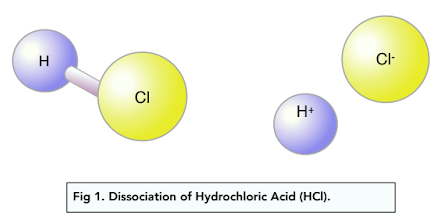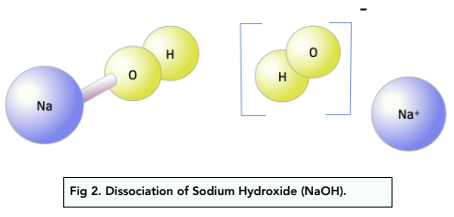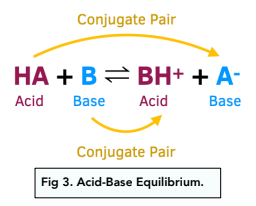Acids and Bases - The Brønsted-Lowry Acid-Base Theory (A-Level Chemistry)
The Brønsted-Lowry Acid-Base Theory
The Brønsted-Lowry Theory
Defining Acids
Acids are defined as proton donors. Acids release H+ ions.

In reality, H+ ions released from an acid in water combine with water molecules to make hydroxonium ions (H3O+).
If HA is any given acid, the ionic equation for forming an acid is:

Acids that, like HCl, release only one proton into solution are called monobasic or monoprotic acids.
Some acids however can release more than one proton: dibasic acids like H2SO4 release two protons and tribasic acids like H3PO4 release three protons.
Defining Bases
Bases are defined as proton acceptors.
In water, a base X, accepts H+ from the water to release hydroxide, OH- ions:


Bases which are soluble in water are called alkalis.
Amphoterism
From the examples above, you would have seen that water can act both accept and donate electrons.
Substances like water which can act either as a base and as an acid are said to be amphoteric.
Acid-Base Equilibria
When an acid releases protons, these gets accepted by another species acting as a base, setting the equilibrium below.

In the forward reaction, a proton gets transferred from HA to B so HA acts as an acid and B as a base.
In the backwards reaction, a proton gets transferred from BH+ to A- so that BH+ acts as an acid and A- as a base.
HA and A- , and B and BH+ are each inked by the transfer of one proton. A pair of species that are related to each other by the difference of a proton is known as a conjugate pair.
The species that gains a protons is referred to as conjugate acid and the species that loses a proton is referred to as conjugate base.
Worked Example: Concentrated sulfuric acid and concentrated nitric acid react together in the equation given. Identify which substance is the acid and which is the base.

Answer: Sulfuric acid has lost a proton and therefore acts as an acid, to form a hydrogen sulfate ion. Nitric acid accepts the proton to form water and a nitronium ion.
Other Acid-Base Models
Before the Brønsted-Lowry theory was developed, other explanations fro acid-base behaviour had been suggested. The main theories that acted as predecessors to the theory used today are:
1) Lavoisier’s Theory – He suggested that acids had to have oxygen in them. Acids whose formulae where known at the time, (namely sulphuric acid, H2SO4, and nitric acid HNO3) did contain oxygen but as it was later seen, not all acids do (HCl, H2S…)
2) Arrhenius Theory – He first suggested that acids and bases dissolved in aqueous solution to release protons and hydroxide ions respectively. He also suggested that acids and bases reacted together to give water and a salt, although this was later shown not to be the case for some bases like ammonia.





Still got a question? Leave a comment
Leave a comment